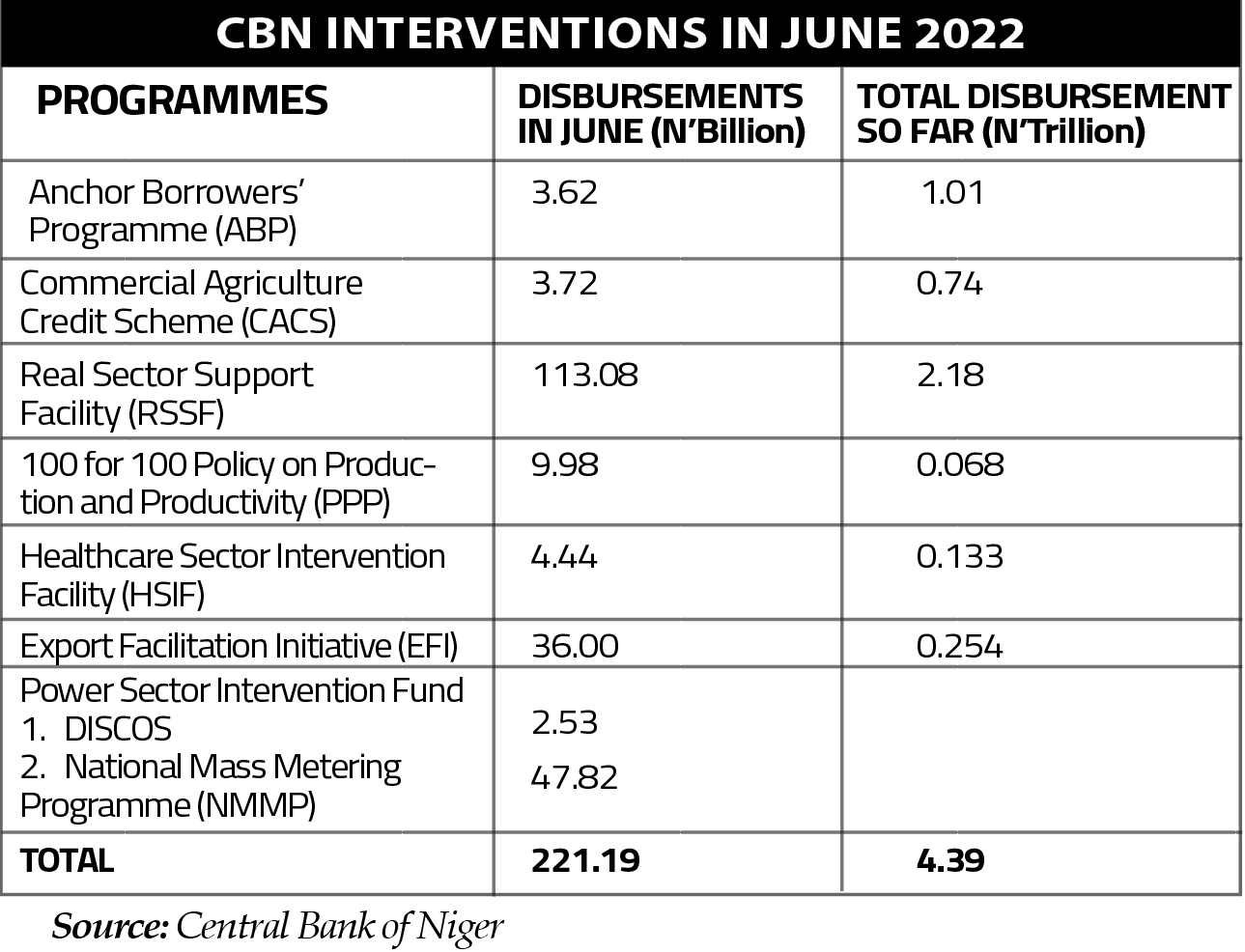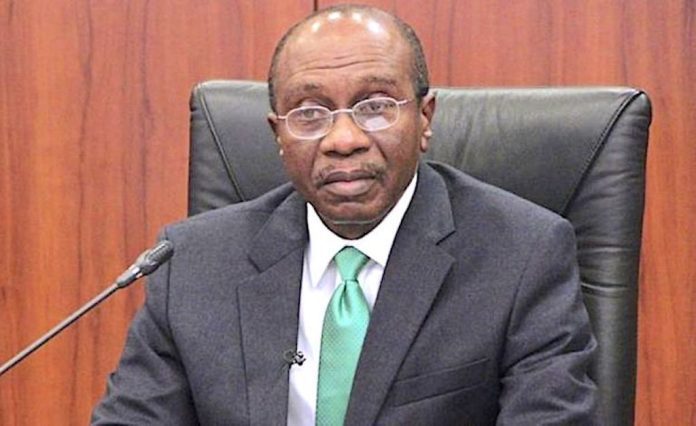The Central Bank of Nigeria injected over N221billion into the economy through its development finance initiatives to eight different intervention programmes in the month of June to further drive economic growth. The disbursements in the review period bring to about N4.39 trillion total sum of money disbursed in the eight areas covered in this report. BAMIDELE FAMOOFO writes.
As at the end of June 2022, the Central Bank of Nigeria has increased its disbursements to eight out of its numerous intervention programmes to about N4.39trillion. Beneficiaries across the eight programmes captured in June received about N221.2billion. The areas of the Bank’s intervention in the review month are agriculture, manufacturing/industries, energy/infrastructure, healthcare, exports and micro, small & medium enterprises.
The manufacturing sector of the economy received the biggest support in the review with disbursements totaling N113.04 billion followed by the energy sector where the National Mass Metering Programme received N47.82 billion while N36 billion was splashed on Export Facility Intervention programme, making it the third largest beneficiary in the June.
On the aggregate level, the Real Sector Facility which borders on stimulating production in Africa’s largest economy, received the biggest chunk of the CBN disbursements as at end of June at N2.18 trillion, representing 49.7 percent of CBN’s total credits.
Anchor Borrowers’ Programme which focuses on achieving food security came next to manufacturing with N1.01 trillion, accounting for 23 percent while Commercial Agriculture Credit Scheme was third on the Bank’s priority list with N744.32 billion.
The Monetary Policy Committee at its July meeting in Lagos appraised the performance of the Bank’s intervention programmes targeted at stimulating productivity with satisfaction and called on the CBN to do more in that direction.
The Committee appraised the continued recovery of output growth, noting that despite the obvious external and internal headwinds, the recovery has remained resilient with hopes of a stronger medium-term recovery. This is, however, hinged on the continued support by the Bank and the Federal government to ensure that recent economic gains are sustained.
“On the aggregate level, the Real Sector Facility which borders on stimulating production in Africa’s largest economy, received the biggest chunk of the CBN disbursements as at end of June at N2.18 trillion, representing 49.7 percent of CBN’s total credits”
Breakdown of interventions
Between May and June 2022, under the Anchor Borrowers’ Programme, the Bank released the sum of N3.62 billion, as disbursements to 12 projects for the cultivation of rice, wheat, and maize, bringing the cumulative disbursement under the Programme to N1.01 trillion, to over 4.21 million smallholder farmers cultivating 21 commodities across the country. The Bank also disbursed N3.72 billion to finance three large-scale agricultural projects under the Commercial Agriculture Credit Scheme. These disbursements brought the cumulative disbursements under this Scheme to N744.32 billion for 678 projects in agro-production and agro-processing.
As part of its effort to support the manufacturing sector, the CBN disbursed the sum of N113.08 billion to 19 new projects under the Real Sector Facility. The funds were utilized for both greenfield and brownfield projects under the COVID-19 Intervention for the Manufacturing Sector and the Real Sector Support Facility from Differentiated Cash Reserve Requirement (RSSF-DCRR).
Cumulative disbursements under the Real Sector Facility currently stands at N2.183 trillion for the financing of 414 real sector projects across the country. Furthermore, under the 100 for 100 Policy on Production and Productivity, the Bank has released N9.98 billion for five projects, bringing the cumulative disbursements under the intervention to N68.13 billion for 48 projects, comprising 26 in manufacturing, 17 in agriculture, three in healthcare and two in the services sector.
In the healthcare sector, the Bank disbursed N4.44 billion to three healthcare projects under the Healthcare Sector Intervention Facility, bringing the cumulative disbursements to N133.42 billion for 129 projects, comprising 76 hospitals, 32 pharmaceuticals and 21 other healthcare services. To further expand the nation’s non-oil export basket under the Export Facilitation Initiative, the Bank released the sum of N36.00 billion for five projects in domestic production and value addition of cocoa and sesame seeds towards improving non-oil foreign currency revenue.
To improve electricity supply in order to lower the overall cost of production in the real sector, the Bank also intervened in the power sector to facilitate the deployment of enabling infrastructure.
Summarily, the sum of N2.53 billion was disbursed to Distribution Companies (DisCos) for their Operational Expenditure (OpEx) and Capital Expenditure (CapEx), under the Nigeria Electricity Market Stabilization Facility – Phase 2 (NEMSF-2). Cumulative disbursement under the NEMSF-2 currently stands at N254.46 billion. Under the National Mass Metering Programme, the Bank disbursed N47.82 billion for the procurement and installation of 865,956 meters across the country.
“Cumulative disbursement under the NEMSF-2 currently stands at N254.46 billion. Under the National Mass Metering Programme, the Bank disbursed N47.82 billion for the procurement and installation of 865,956 meters across the country”
MPC’s appraisal
The Committee also noted that both the Manufacturing and Non-Manufacturing Purchasing Managers’ Indices increased above the 50-index point benchmark to 51.1 and 50.3 index points in June 2022, compared with 48.9 and 49.9 index points, respectively, in May 2022. This reflects the continued rebound in economic activities due to improvements in supplier delivery time; raw materials inventory; employment levels as well as expansion in some sectors such as agriculture, accommodation, electricity, amongst others.
The Committee called on the Federal Government to prioritize efforts to curb the menace of insecurity to enable farming and other business activities return to normalcy. The MPC thus called on the Bank to continue its support to increase food supply in a bid to address food inflation. Members also noted the upward price pressure, particularly on transportation, resulting from the prolonged scarcity of Premium Motor Spirit and called on the Federal Government to seek a long-term and viable solution to strike a balance between the pricing and supply of PMS in Nigeria.
The MPC noted that the current upsurge in price levels remains a primary concern to monetary policy as members focused on the optimal policy approach required to address this development while protecting the fragile recovery. The committee clearly identified that inflationary pressure was being driven by both demand and supply-side factors, which should be addressed using different policy approaches. In the committee’s view, the demand-side factors were being broadly addressed by the Bank, using the relevant direct and indirect instruments. On the supply side, the Bank has continued to provide the necessary support, through its development finance initiatives in the real sector, to ease supply constraints.
Recommendations
The committee called on the Federal Government to prioritize efforts to curb the menace of insecurity to enable farming and other business activities return to normalcy. The MPC thus called on the Bank to continue its support to increase food supply in a bid to address food inflation. Members also noted the upward price pressure, particularly on transportation, resulting from the prolonged scarcity of Premium Motor Spirit and called on the Federal Government to seek a long-term and viable solution to strike a balance between the pricing and supply of PMS in Nigeria.


